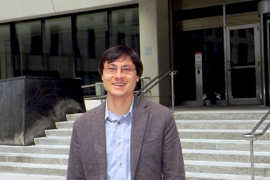A physicist, a mathematician, and an economist walk into a bakery. It sounds like the opening of a witty one-liner, but for Jeff Gore, the Latham Family Career Development Assistant Professor of Physics at MIT, it marks the beginning of a career.
Gore — who actually is a physicist, mathematician, and economist (he also studied electrical engineering and computer science at MIT as an undergraduate and studied biophysics as a graduate student at the University of California at Berkeley) — now uses his observations of the behavior of baker’s yeast as a way to translate heady theories about evolution and ecology into practical indicators that an ecosystem is headed for a change. His work is already beginning to help field biologists and ecologists detect and respond to troubling environmental trends such as vanishing fisheries and collapsing honeybee colonies.
“There are a lot of really beautiful ideas in theoretical ecology but it’s difficult to test those ideas with any sort of experiment,” says Gore. “We see an exciting opportunity to take our experimentally tractable microbial communities and do theoretically motivated experiments.”
Gore’s approach to the study of ecology and evolution is guided by the idea that complex systems, such as populations of living organisms, follow universal patterns of behavior. Those patterns can be expressed mathematically with formulas that exhibit special features, such as stable states and tipping points. A tipping point, a phenomenon popularized by Malcolm Gladwell in his book, "The Tipping Point," is a critical moment of change, such as the moment when a pot of water accumulates enough heat to boil, or, more alarmingly, the moment the atmosphere accumulates enough heat that climate patterns shift irreversibly.
Tipping points occur in populations of organisms that cooperate to survive. For instance, baker’s yeast collectively breaks sucrose into smaller sugars that can be used as fuel. This team effort helps stabilize the population by ensuring there is enough fuel to go around. “But if the population gets too small, it can’t break down enough sugar to survive,” says Gore. “The population collapses.”
Gore’s studies of thriving yeast colonies and colonies under duress have uncovered telling signs that a colony is on the verge of tipping into oblivion. In one study, Gore and colleagues found that colonies nearing a tipping point take longer to recover from challenges, such as an influx of salt that substantially slows the growth of the yeast population. “The recovery time grows as you get closer to the tipping point,” says Gore. “We can measure this in the lab with yeast.”
This recovery slowdown isn’t just a phenomenon seen in baker’s yeast. Rather, it will occur in other populations with similar cooperative foundations, such as packs of wolves that hunt collectively, schools of fish that travel together, or colonies of bees that work together. Because of this universality, a slowdown in recovery could become an early warning that a population is on the verge of collapse. “It may be possible to anticipate that a tipping point is approaching before we cross that threshold, which is important because once a threshold is crossed, it can be very difficult to reverse,” says Gore.
Recently, Gore and graduate student Lei Dai have begun applying these findings in collaboration with Christina Grozinger, a honeybee biologist at Pennsylvania State University. Honeybee colonies are collapsing at an alarming rate worldwide and researchers have been looking for new ways to approach understanding and preventing colony collapse disorder. In unpublished work, the researchers found that honeybee colonies need a critical mass of bees to survive. “Smaller colonies all collapse,” says Gore.
The work is a first step towards applying the warning signs Gore sees in yeast to natural ecosystems and even complex biological systems, such as cancer. “Depending on the population you’re talking about, you either want it to collapse or not,” he says. “In the case of a tumor, we do.”
In an effort to create laboratory experiments that more closely resemble natural ecosystems, Gore is beginning to work with microbial colonies that involve more than one species. “We want to understand how the dynamics play out when we have more complex communities,” he says.








